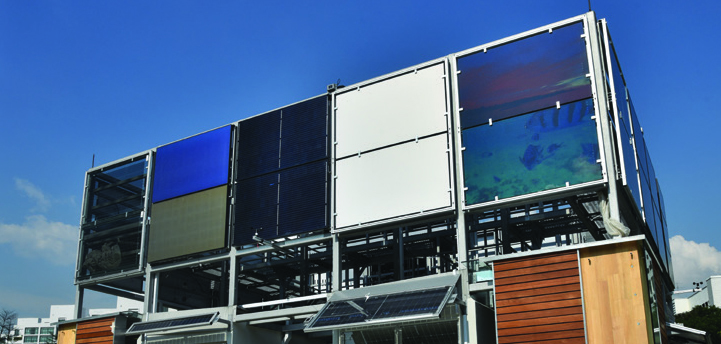
What does a solar panel look like?
This is a question that we have been thinking a lot about since we founded the Land Art Generator Initiative in 2008 and launched the first LAGI design competition in 2010. At that time there were already a range of interesting technologies being developed and coming to market, including colorful organic photovoltaic thin films, dye-sensitized solar cells, and innovations like Sphelar™. We included some of these in our first Field Guide to Renewable Energy Technologies in order to get the word out to designers, artists, architects, landscape architects, and other creatives.
Our goal has always been to inspire people to use renewable energy technologies as a medium for creative expression in every design project, including public parks, destination landscapes, civic art, residential gardens, architecture, and everyday design objects. This is especially possible with solar photovoltaic technology because it is so incredibly versatile!
Over the past decade there have been a number of fascinating developments in solar module technology, lamination glass, and special films. Below is a list of some of the products that are out on the market today. Any of these can be excellent media for art in public places—making our cities more beautiful as we make them more sustainable. All images are courtesy of the website linked to for each unless otherwise noted.
Monocrystalline Silicon and Thin Films
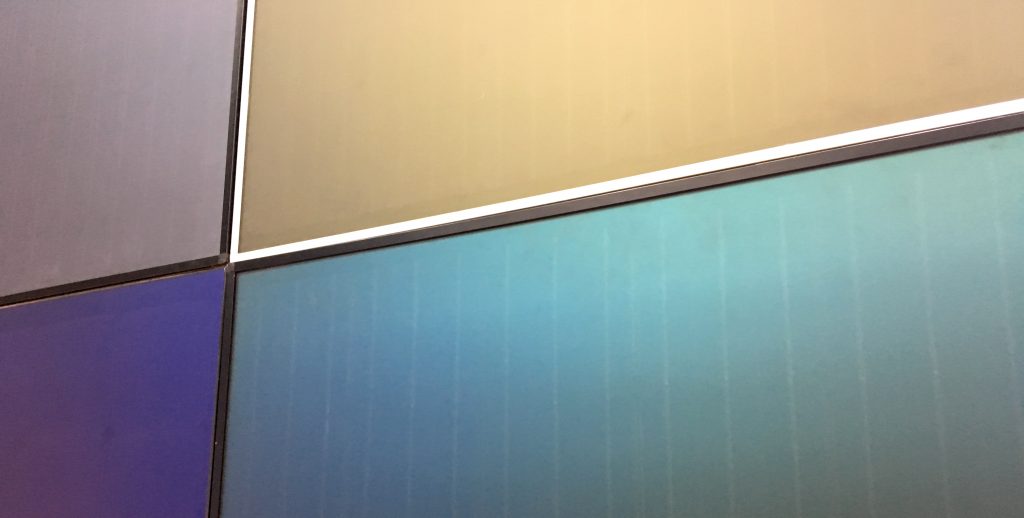
Kromatix™ by SwissINSO is a custom color-treated glass face laminate that is applied during the solar module production process. It can be applied over pretty much any kind of photovoltaic panels (PV) or over flat solar thermal modules. The technology is a highly efficient and environmentally friendly nanotechnology surface treatments for a kind of structural color in grey, blue, blue-green, orange, bronze, and brass. Because it is integrated into the module glass Kromatix™ is laminated at the panel manufacturer’s factory, not in the field.

Invent uses their InvisibleCell® technology that hides the busbars, gaps, and electrical finger connections that appear silver/white on a standard PV module behind an all-black face laminate. With small variations in the pattern of the glass, they are able to create greyscale patterns of any kind. Panels can work together to create larger compositions.

Solaxess allows any exterior building surface to be a solar power generator. All of the white finish panels that you see in the photograph above are generating electricity from standard solar panels concealed behind the custom Solaxess laminate.
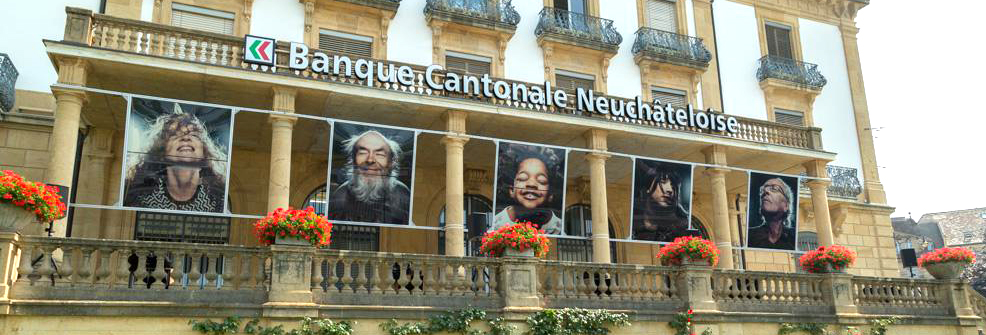
Kaleo in Neuchâtel, Switzerland has a version of a printed film that is applied to the face of a solar module. The glossy finish is great for photographs with a look very similar to a C-print on transparency film. The solar module making electricity behind is completely invisible, obscured by the beauty of the artwork.
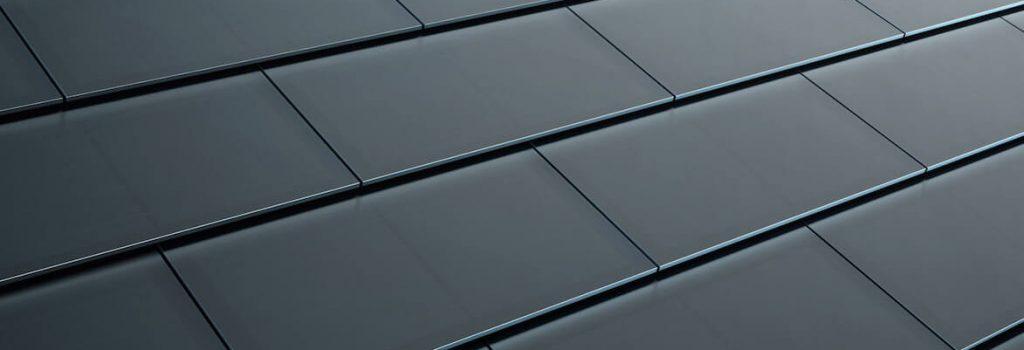
Tesla Solar Roof tiles use a series of small “louvers” within the top encapsulant layer of laminated glass that obscure the inner workings of the solar module when viewed from the range of angles one might normally expect to have to a rooftop from the street. Meanwhile, the angle that the sun hits the tiles normally throughout the day has an unobstructed path to the solar cells. This is kind of like the way a lenticular image works to show one graphic when viewed from a certain angle and another graphic when viewed from a different angle. You can learn more in Tesla’s patent application. Ever since this product was announced, we at LAGI have been curious to see what an artist might do with this product when set free from the confines of a pitched roof.
Update: As the Tesla Solar Roof tiles have struggled to meet demand and installations have slowed, the roofing major Certainteed has introduced its version. It is a bit simpler with less masking of the solar cells and bus bars, but it still provides a nice result at a more affordable price point and with less lead time. Other very stylish solar roof tiles for terra cotta or slate replacement suitable for listed historic sites can be found from the Swiss company FreeSuns and Italian company Dyaqua.

Update: SunStyle is taking a different approach to solar roofing. Often referred to as “dragonscale” solar tiles, the product offers a great deal of flexibility in design. It has been installed on high profile projects like the 7 MW capacity Google HQ canopy (detail above) as well as on residential rooftops, where it equally complements a contemporary or cottage aesthetic. The face material has a texture that conceals the recognizable solar cell and busbar components while maintaining a high conversion efficiency.
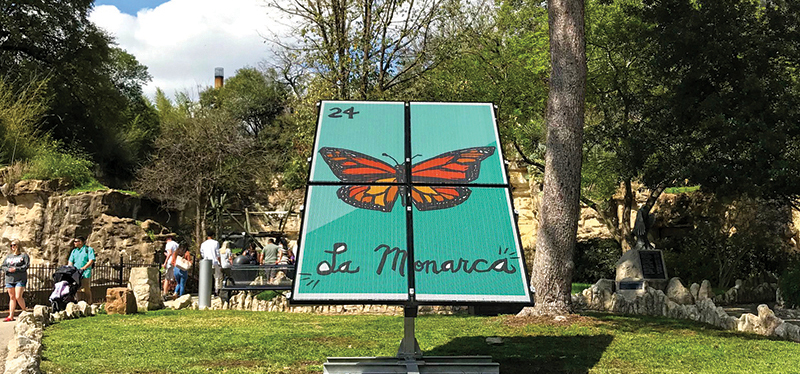
Sistine Solar makes a film—SolarSkin—onto which any graphic image can be printed. The special film allows almost all of the light through to the solar cells to generate electricity. The product was developed at MIT by the company’s founders, and has been marketed as a way to disguise solar panels on rooftops by printing a full-scale image of the surrounding roof shingle pattern, color, and texture. But the technology allows you to print literally anything, not just roof shingles. For example, we specified Sistine Solar on the world’s first Solar Mural installation, which was installed in San Antonio in 2017. The La Monarca image was designed by San Antonio artist Cruz Ortiz with creative direction by Penelope Boyer. You can read more about La Monarca and the LAGI Solar Mural program at solarmural.com.
Sistine Solar SolarSkin can also be exchanged in the field, so if an artwork that uses the film would like to change at some point in the future that is possible, without replacing the solar modules themselves. As with many of the surface applications listed in this article, there is a small trade-off on electrical conversion efficiency with this product, so a solar module that would normally be 20% efficient under ideal conditions will operate at 16-18% under the same conditions—a small price to pay for the versatility and beauty of this option!
Other companies that can provide similar custom graphic prints over standard monocrystalline silicon solar photovoltaic include Mitrex and Solar Visuals.
Dutch Solar Design Photovoltaics is another applied film that can be printed with any image. They specialize in building textures that make the solar modules disappear into the building facade. See the link to their site for photographs.

ColorBlast uses a ceramic printing technique on the face of the module glass that lets sunlight through to the solar cells.
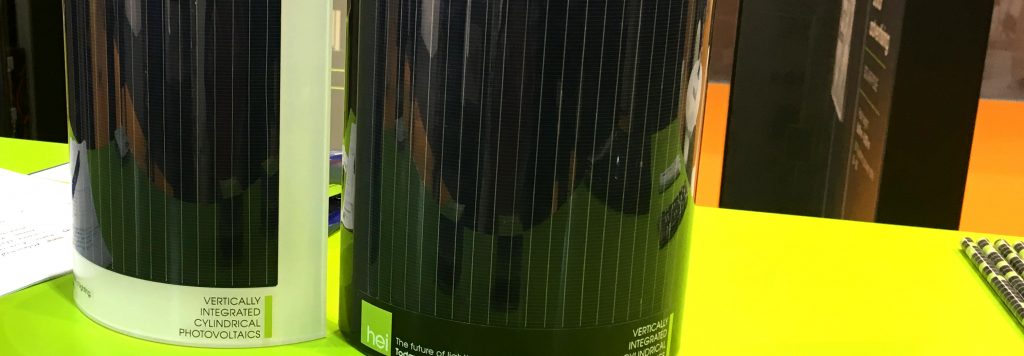
Hei makes curved modules that are meant to be integrated into exterior lighting poles. In that context they are an elegant solution for cities. We wonder if the modules could be also used by an artist in a more creative manner?
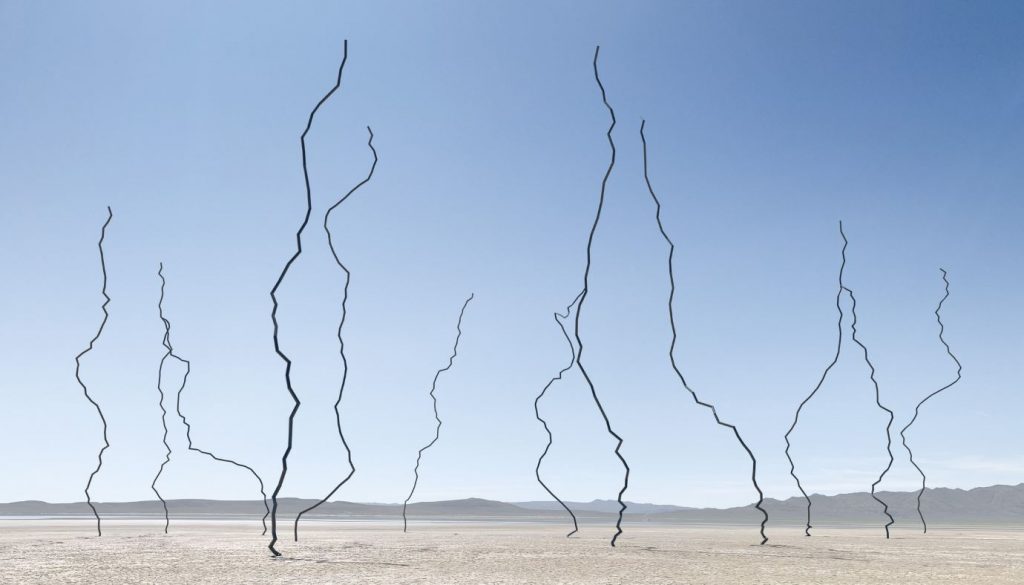 Update: After we published this post in 2019, the artist and architect Antonio Maccà answered the call by using Hei modules as the primary design element for his “Drawings” proposal to LAGI 2020 Fly Ranch, that include the lightning bolt shapes, seen in the image above striking the Hualapai Flat. At night the bolts glow with embedded LED lights that use a small percentage of the energy generated during the day, most of which is fed to support activities at Fly Ranch.
Update: After we published this post in 2019, the artist and architect Antonio Maccà answered the call by using Hei modules as the primary design element for his “Drawings” proposal to LAGI 2020 Fly Ranch, that include the lightning bolt shapes, seen in the image above striking the Hualapai Flat. At night the bolts glow with embedded LED lights that use a small percentage of the energy generated during the day, most of which is fed to support activities at Fly Ranch.

Onyx Solar specializes in building integrated PV of various types, like the almost completely transparent glazing option shown in the image above.
Polycrystalline Silicon PV
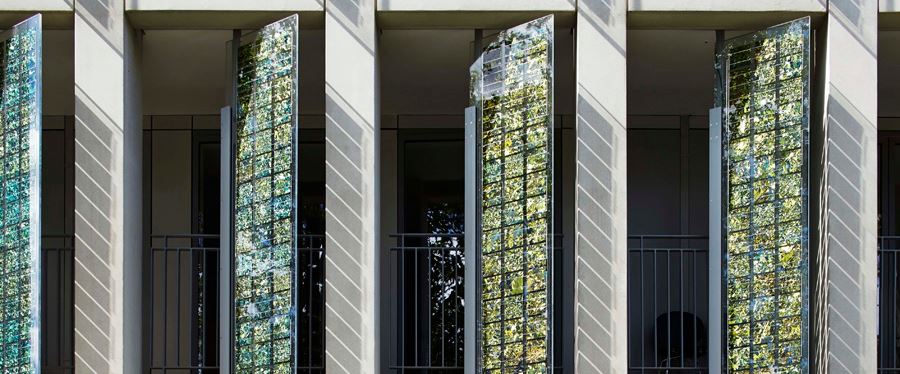
LOF Solar makes polycrystalline solar cells of almost any color that can be integrated into custom modules.
Organic Photovoltaic Thin Film (OPV)

Heliatek makes flexible and colorful OPV film that can be applied in a variety of creative applications.

OPVIUS specializes in OPV that can be fabricated in custom shapes like the hexagonal forms integrated into the German Pavilion at the Milan Expo in 2015. Update: OPVIUS merged with the Armor Group of companies in 2019 and is now ASCA.
Dye-sensitized Solar Cells (DSSC)

Solaronix specializes in dye-sensitized solar cell production. You can see their technology installed at the EPFL Convention Center in the image above.
Luminescent Solar Concentrator (LSC)
ClearVue is a fascinating technology that results in a 70%+ clear glass pane that generates electricity by channeling the right wavelengths of light to the edges of the module where the PV cells are located.
If you know of any other products out there, please send us an email at lagi@landartgenerator.org and let us know about them!
To close, we’ll leave you with this beautiful image of the winning design from the 2018 Land Art Generator Initiative design competition for Melbourne. Light Up, uses a solid color lamination over monocrystalline silicon solar PV modules to create this stunning work of art for St Kilda Triangle.
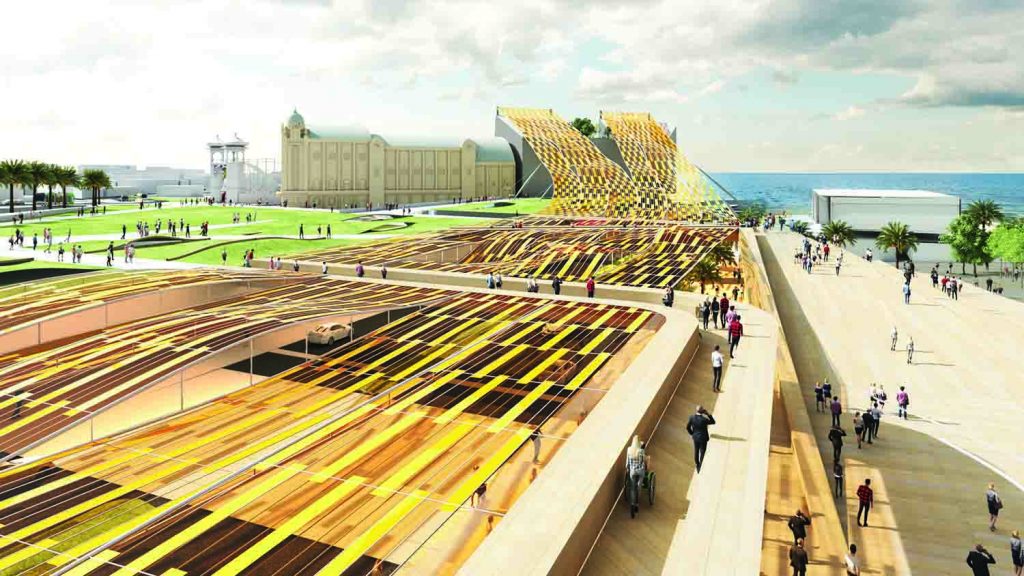
Artist Team: Martin Heide, Dean Boothroyd, Emily Von Moger, David Allouf, Takasumi Inoue, Liam Oxlade, Michael Strack, Richard Le; Mike Rainbow, Jan Talacko; John Bahoric; Bryan Chung, Chea Yuen Yeow Chong, Anna Lee, Amelie Noren
Energy Technologies: flexible mono-crystalline silicon photovoltaic, wind energy harvesting, microbial fuel cells
Annual Capacity: 2,220 MWh
A submission to the 2018 Land Art Generator design competition for Melbourne
Related Posts
2 Comments
Add comment Cancel reply
This site uses Akismet to reduce spam. Learn how your comment data is processed.

[…] isn’t the first, or likely the last, exploration of renewable energy as art. While some opponents to clean energy projects note the less-than-attractive appearance of solar […]
Greetings! I am Mario S Diaz….I own 1635 W Pacific Coast Highway Long Beach, California 90810 USA. I would like to utilize BIPV on the remodel/redevelopment aspirations I have for my property. Im hoping the City of Long Beach Planning Department approves my hope to use my property in a mixed use ( Live/work ) function…if so, I would like to keep the front structure white and use white BIPV…and I would like to refurbish the backyard storage structure to be an accessory dwelling unit….the backyard dwelling unit I would like to mimic a tree so I would use brown and green modules. Aesthetics is more important to me than module efficiency ratio. Both front and rear would be developed upwards to 2 stories….This property is very highly visible and trafficked by all types of vehicles….and it is directly on a transportation and retail fueling corridor utilized by container hauling truckers conducting business in the Ports of Los Angeles and Long Beach…Let me know if you can assist my aspirations in Long Beach California. Thank You.